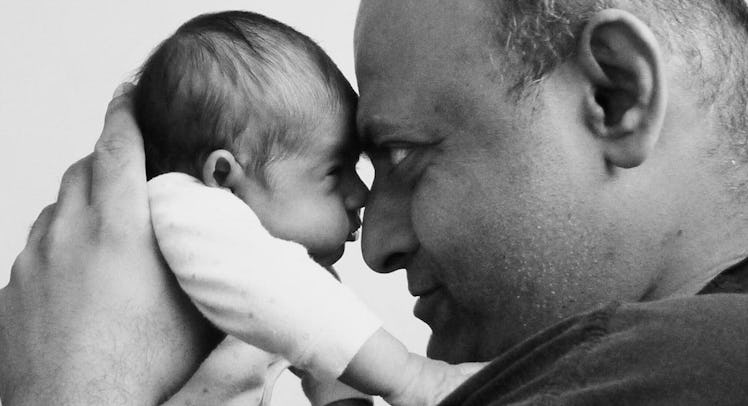What’s Parental Leave’s Biggest Benefit? Building Confident Fathers
A discussion with Brad Harrington, director of Host College's Center for Work and Family.

The state of parental leave in the U.S. is dismal. This, we know. And, often, that conversation can become a bit of a downer.
If you’d prefer to talk about paternity leave from an empirical perspective, rather than an abstractly depressing one, then you will relish the work of Brad Harrington, director of Boston College’s Center for Work and Family. Harrington has spent the better part of the last decade authoring a number of illuminating studies that have quantified just how bad of a job our society is doing helping new dads connect with their babies. His work is useful and important, serving to illuminate the desire many fathers have to be a part of their family, why they feel forced into certain roles, and that, while, the legislative hurdles we must leap over, while high, lead to a better place. Here are some of Harrington’s largest points.
READ MORE: The Fatherly Guide to Parental and Paternity Leave
Dads Want to Be More Involved Than Society Allows
In one of their studies, Harrington and his team asked about 1,000 dads how they viewed their role at home, on a continuum from breadwinner to caregiver. “You heard from fathers that they wanted to be more engaged than their own fathers were,” he said. Nearly three-quarters said they saw themselves as equal parts both. “That was a more balanced view than we expected. We thought fathers would have a bias toward breadwinning,” he says. But their actual role at home doesn’t quite fit that ideal: Even though two-thirds of guys said they want to split caregiving 50-50 with their partner, only about one in three guys reported duties were in fact split. The remaining majority said that they carried out considerably less than half of the caregiving. “The disconnect in what they wanted to do and what they did was big.”
Paternity Leave Is Essential For Building Engaged, Confident Fathers
In his research, Harrington has found that only about 75 percent of dads take as much as a week off for paternity leave (and that a vanishingly small number take more than two weeks, and a depressing 15 percent go back to work the next day). Unfortunately, the dearth of paternity leave time has ramifications that can last a lifetime. “They’re not really experiencing caregiving in any meaningful way in those few days, and not understanding how to care for a kid solo,” Harrington says. These short moments fathers spend with kids at the early stage of their kid’s life aren’t enough to build confidence in their parenting ability. And it’s time they can never get back. “It’s unlikely the father will ever be a true equal, and that pattern has a reinforcing effect: The more a mother cares for a kid, the more she feels able to do. The less a father feels able, the more he steps back.” (Editor’s Note: Harrington’s study population has been college-educated men in white collar jobs, so they may actually have better access to paid paternity leave than other populations, making the outlook even worse for a broad swath of Americans.)
Paternity Leave Is On Everyone’s Mind
In 2014, Harrington focused his efforts on trying to find out what men wanted and expected for paternity leave. “We were trying to find out men’s perceptions,” he said. Posing the question to more than 1,000 fathers who had at least one child under the age of 18, he asked how important paid paternity leave would be if they were looking for a new job. Nearly 90 percent of the surveyed fathers said that leave was somewhat, very or extremely important to very important on their personal radar, with 60 percent of those men falling in the very or extremely category. In terms of pay, around 85 percent said they’d have to get 70 percent of their full pay to take the leave. “Their ideal was two-to-four weeks off,” Harrington said. He points out that their sample population was biased because, sadly, these guys were among the small minority across the country who had access to some paid paternity leave, however short.
Dads Should Learn Something from the Women’s Movement
Women have always had a place in the home but have had to struggle for it in the workplace, Harrington points out. Men are in the opposite position. Feminism didn’t happen overnight, but if men want to be heard about paternity leave, they might have to learn something from that and get louder. “There was a powerful coalition that martialed their clout to make sure it happened,” Harrington says. “I don’t see a parallel activity going on. There’s no Gloria Steinem of the men at home movement.” Harrington hasn’t seen leaders strong and charismatic enough on the issue to stoke anything more than lukewarm attention. “Women are filling traditionally male-oriented roles but men aren’t doing the reverse.”
There Won’t Be A Tipping Point Anytime Soon
“A stronger national policy would be great but I don’t see that happening,” Harrington says. Instead, he thinks states, municipalities, and forward thinking companies will continue to add incrementally to paid paternity leave. “At some point, there will be a tipping point, but we’re not there yet.” And until then, he says, it’s not just fathers and children who bear consequences. “Employers need to step up and say if we want to see women advance then we need to encourage men to take leave or give flexible work arrangements.”